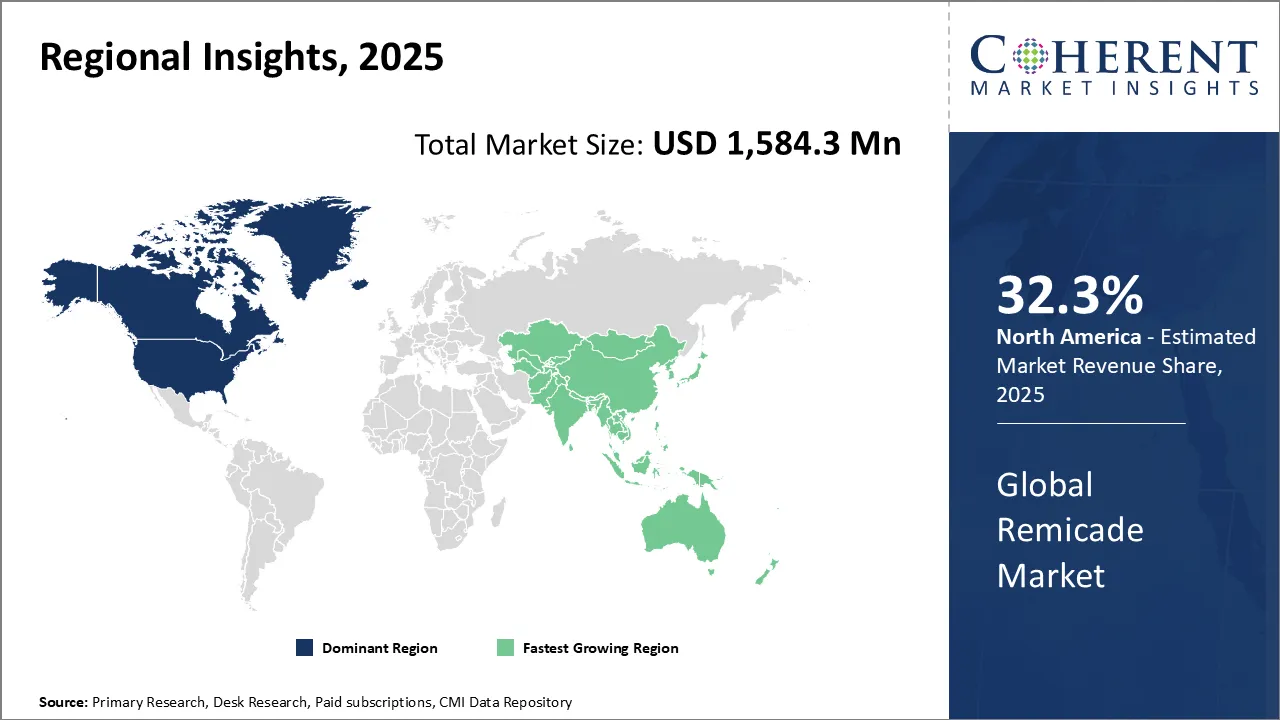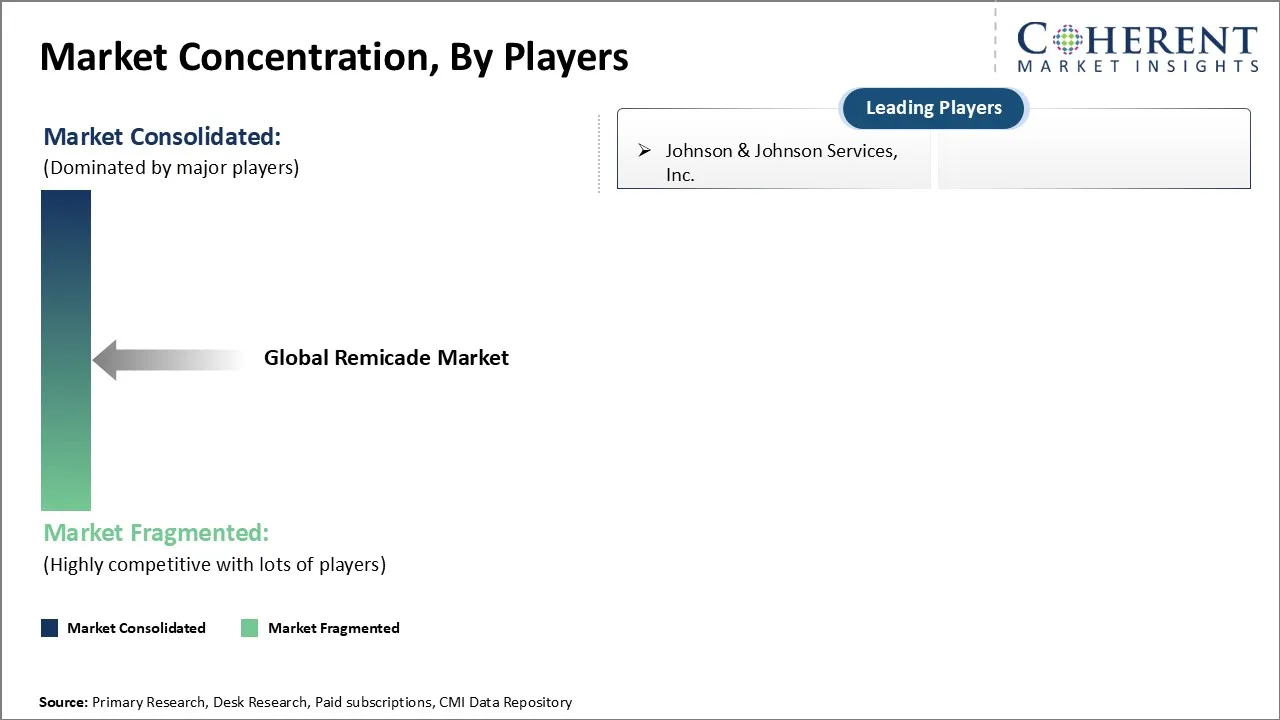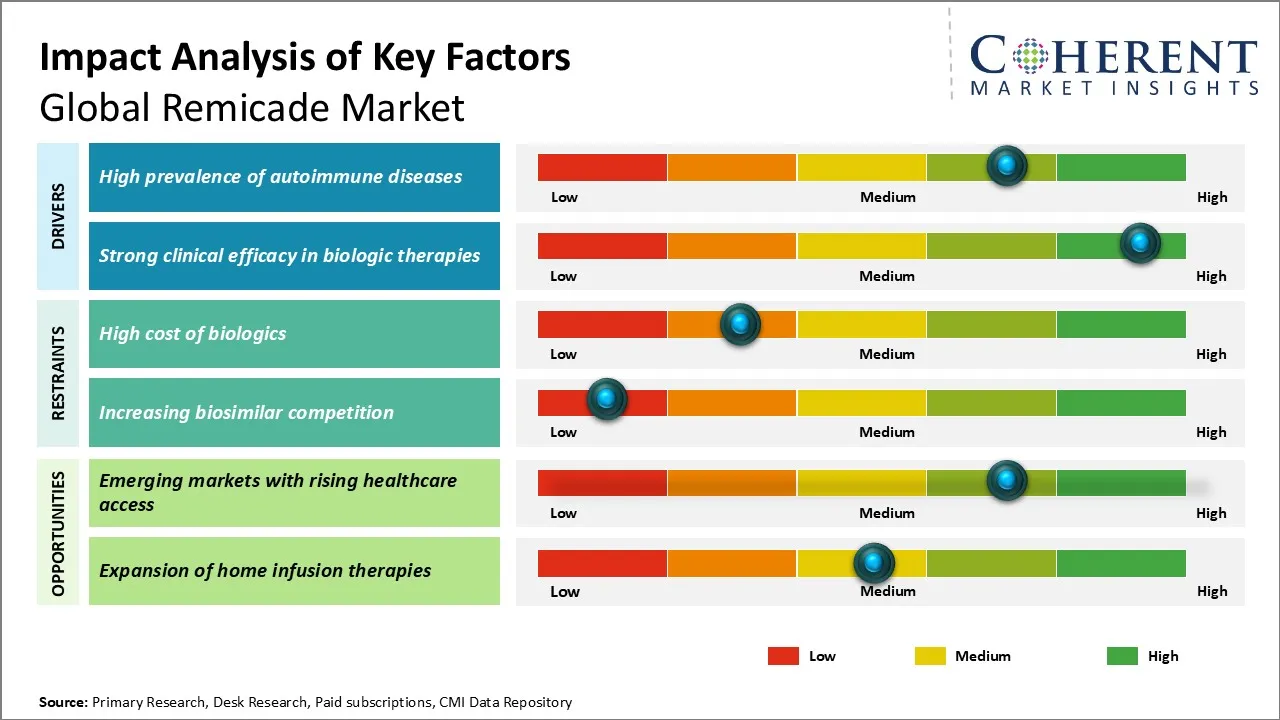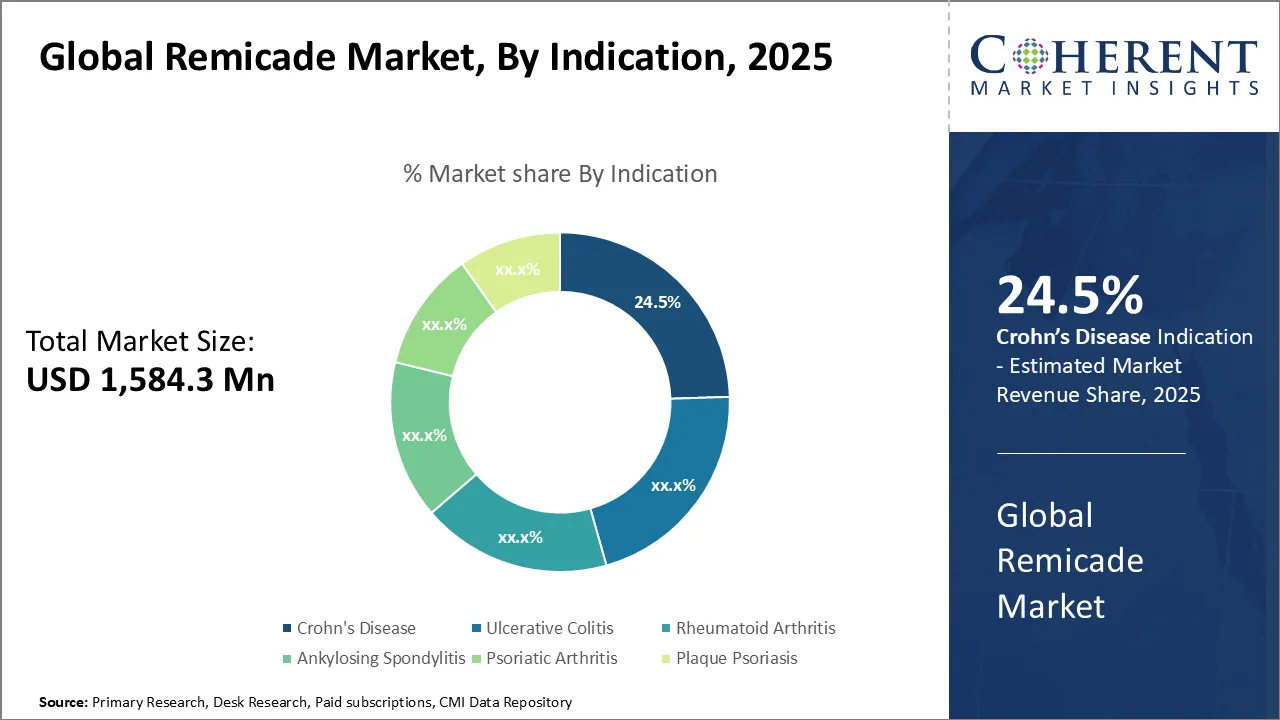Global Remicade Market Size and Forecast – 2025 to 2032
The Global Remicade Market is estimated to be valued at USD 1,422.0 Mn in 2025 and is expected to reach USD 655.0 Mn by 2032, exhibiting a compound annual growth rate (CAGR) of –10.48% from 2025 to 2032. While the market has historically grown due to the increasing prevalence of chronic inflammatory diseases like rheumatoid arthritis, Crohn's disease, and ulcerative colitis, as well as the demand for biologic therapies, several factors are limiting its future growth. The emergence of biosimilars, pricing pressures, and potential side effects associated with Remicade are contributing to a downturn in the market. Despite these challenges, ongoing research and innovation in biologics present some opportunities for further market development.
Key Takeaways of the Global Remicade Market
- In 2025, Crohn's Disease segment accounts for the largest share of the Remicade market by indication, contributing an estimated 24.5%market share.
- By patient age group, the adult segment is expected to represent the dominant segment, holding a 40.2% market share in 2025.
- From a distribution channel perspective, the hospital pharmacies segment is expected to lead the market with a 39.3% share in 2025.
- North America is expected to lead the market, holding a share of 32.3% in 2025. Asia Pacific is anticipated to be the fastest-growing region, with a market share of 25.4% in 2025.
Market Overview
The Remicade market is experiencing a decline, driven by the expiration of its patent and the increasing development of biosimilars. Several pharmaceutical companies are investing in biosimilars, which are expected to be more affordable and accessible for patients, further contributing to the market's decrease. Additionally, advancements in genetic testing and biomarker identification are enabling healthcare providers to tailor treatment plans, but the overall market is shrinking as more cost-effective alternatives become available.
Current Events and Its Impact
|
Current Events |
Description and its impact |
|
Technological Advancements in Drug Delivery |
|
|
Surge in biosimilar approvals |
|
Uncover macros and micros vetted on 75+ parameters: Get instant access to report
Remicade Market Insights, By Indication - Crohn's Disease dominates due to high prevalence of Crohn’s disease globally
In terms of indication, Crohn's disease is expected to contribute the highest market share of 24.5% in 2025. Crohn's Disease is a chronic inflammatory bowel disorder that can affect any part of the gastrointestinal tract, causing symptoms such as abdominal pain, diarrhea, weight loss, and fatigue. The increasing prevalence of Crohn's Disease Inflammatory bowel disease (IBD) worldwide can be attributed to improved diagnostic techniques, changes in diet and lifestyle, and genetic susceptibility.
For instance, in June 2024, according to Centers for Disease Control and Prevention, inflammatory bowel disease (IBD) in the U.S. affects 2.4 to 3.1 million people, with the highest prevalence among populations. IBD-related healthcare costs were USD 8.5 billion, primarily due to biologic medications. IBD is more common in older adults and is linked to poorer health behaviors, such as smoking and inadequate sleep. The rise in biologic treatments has improved patient outcomes but increased healthcare expenses.
Remicade Market Insights, By Patient Age Group - Adult dominates due to stronger treatment adherence and disease awareness in adult populations
In terms of patient age group, the adult segment is expected to contribute the highest market share of 40.2% in 2025. Firstly, the incidence of conditions treated by Remicade, such as Crohn's Disease, Ulcerative Colitis, and Rheumatoid Arthritis, is higher in the adult population compared to pediatric and geriatric patients. This higher prevalence translates into a larger patient pool requiring treatment with Remicade, driving the market growth in this segment.
Moreover, adults are more likely to seek and adhere to long-term treatment plans for chronic conditions, which is crucial for the success of Remicade therapy. Adult patients tend to have a better understanding of their disease and the importance of consistent treatment, leading to higher compliance rates and, consequently, better outcomes. This, in turn, encourages healthcare providers to prescribe Remicade more frequently to their adult patients.
Remicade Market Insights, By Distribution Channel - Hospital Pharmacies' Dominance Due to Intravenous Administration and Professional Supervision
In terms of distribution channel, the hospital pharmacies segment is expected to contribute the highest share of 39.3% in 2025 due to several crucial factors. Remicade is a prescription medication that requires close monitoring and administration by healthcare professionals, making hospital pharmacies the preferred choice for its distribution. The drug is often administered through intravenous infusion, which is typically carried out in a hospital setting under the supervision of trained medical staff. This ensures proper dosing, monitoring of adverse reactions, and patient safety, thus driving the dominance of hospital pharmacies in the Remicade market.
Pricing Analysis of Remicade Market
- The pricing of Remicade in 2025 reflects substantial global variation, influenced by national healthcare policies, reimbursement systems, and market dynamics. In high-income countries like the United States, Remicade remains one of the most expensive biologics, averaging USD 1,257 per 100 mg vial, closely followed by Slovakia at USD 1,250. Other Western European nations like Germany (USD 820), Norway (USD 889), and the Netherlands (USD 780) also report elevated prices, though generally lower than in the U.S. This high-cost burden in the U.S. is further underscored by the out-of-pocket range of USD 1,174.8–1,345.0 for uninsured patients, reflecting limited pricing controls and varying insurance coverage.
- Conversely, several European nations such as Sweden (USD 224), Austria (USD 269), and France (USD 326) exhibit significantly lower pricing, attributed to centralized price negotiations and stronger public healthcare systems. Emerging markets like South Africa (USD 440) and the U.A.E (USD 755) fall mid-range, offering a glimpse into improving access to biologics. Japan, with an average price of USD 650, represents a mature biologics market with strong governmental price regulation. The pricing disparities across regions underscore the critical role of national pricing frameworks, biosimilar competition, and public procurement policies in determining access and affordability for patients globally.
Regional Insights

To learn more about this report, Download Free Sample
North America Remicade Market Analysis and Trends
North America dominates the global remicade market with an estimated share of 32.3% in 2025. The region boasts a well-established healthcare infrastructure, coupled with a high adoption rate of innovative biologics. The presence of major pharmaceutical companies, such as Johnson & Johnson, which manufactures Remicade, further solidifies the region's position. Moreover, favorable reimbursement policies and a strong emphasis on research and development have contributed to the market's growth. The U.S., in particular, has been at the forefront of adopting Remicade for the treatment of various autoimmune disease treatment, such as rheumatoid arthritis, Crohn's disease, and ulcerative colitis. The country's large patient population and increasing awareness of biologic therapies have further fueled the demand for Remicade in the region.
For example, in February 2025, according to the WHO, biologic medicines have revolutionized the treatment for chronic conditions like cancer and autoimmune diseases, offering significant benefits in efficacy and safety. However, their high costs limit access, especially in low- and middle-income countries (LMICs). Biosimilars, highly similar versions of biologics, are changing this by providing affordable alternatives. With increasing manufacturing capacity in middle-income countries, biosimilars are now more accessible and cost-effective, being about 60% cheaper than the original biologic therapies.
Asia Pacific Remicade Market Analysis and Trends
The Asia Pacific region is expected to exhibit the fastest growth in the global remicade market with a share of 25.4% in 2025. This growth can be ascribed to several factors, including the rising prevalence of autoimmune diseases, improving healthcare infrastructure, and increasing healthcare expenditure. Countries like China, Japan, and South Korea have witnessed a surge in demand for Remicade due to their large patient populations and growing awareness of biologic treatments.
Additionally, the expanding middle class and increasing disposable incomes in the region have made advanced therapies more accessible. Governments in the Asia Pacific region have also been supportive of the pharmaceutical industry, implementing policies to encourage foreign investment and local manufacturing. This has attracted global players to establish their presence in the region, further driving market growth.
Global Remicade Market Outlook for Key Countries
U.S. Remicade Market Trends
The U.S. market for Remicade is experiencing a decline, despite a well-established healthcare system, high patient awareness, and favorable reimbursement policies. Johnson & Johnson, the manufacturer of Remicade, continues to have a strong presence in the country, ensuring the drug's availability. However, the market is shrinking due to the increasing prevalence of biosimilars and the emergence of alternative biologic therapies, which may erode Remicade's market share over time. While the drug has proven efficacy in managing autoimmune disorders, its market is facing growing competition.
For example, Johnson & Johnson, a global healthcare leader, is known for its wide range of products in pharmaceuticals, medical devices, and consumer health. Its Janssen Biotech division developed Remicade a biologic drug approved in 1998. Remicade targets TNF-α to treat autoimmune diseases like rheumatoid arthritis, Crohn's disease, and psoriasis.
Japan Remicade Market Trends
Japan's market for Remicade, once driven by a high prevalence of autoimmune diseases, is now experiencing a decline. The aging population and rising healthcare expenditure had initially supported the demand for biologic treatments. Janssen Pharmaceutical K.K., a subsidiary of Johnson & Johnson, played a crucial role in promoting Remicade. However, with the introduction of biosimilars and shifting healthcare policies, Remicade's market position is weakening, and the outlook for the future is less certain.
Germany Remicade Market Trends
In Germany, Remicade's market remains significant, but it is facing a downturn due to the emergence of biosimilars and cost-effective alternatives. The country’s well-established healthcare system and high prevalence of autoimmune disorders had initially driven demand. However, despite Janssen Biotech's efforts in physician education and patient support programs, Remicade is facing challenges from newer therapies, leading to a decline in market growth.
For instance, in November 2023, according to National Library of Medicine, in Germany, the prevalence of rheumatoid arthritis (RA) is around 1.26%, with women being more likely to develop the condition than men. This measure helps understand the disease burden on the population and informs healthcare decisions, including resource allocation and treatment strategies.
China Remicade Market Trends
China's market for Remicade, once rapidly expanding, is now also showing signs of slowing down. The large patient population and increasing healthcare expenditure had initially fueled growth, particularly due to the rising prevalence of autoimmune diseases. Xian Janssen Pharmaceutical Ltd., a subsidiary of Johnson & Johnson, led the market entry for Remicade. However, with the evolving healthcare reforms and the introduction of biosimilars, the market is now facing significant challenges in terms of pricing and reimbursement, contributing to a decline in Remicade’s market presence.
For instance, in August 2024, as per National Library of Medicine’s systematic review and meta-analysis examined the incidence and prevalence of eight autoimmune diseases in the adult Chinese population. The study found that autoimmune diseases affect 2.7-3.0% of adults in China, which equates to over 31 million people. The most prevalent conditions were autoimmune thyroid diseases and rheumatoid arthritis. Women were nearly twice as likely as men to be diagnosed.
Market Players, Key Developments, and Competitive Intelligence

To learn more about this report, Download Free Sample
Key Developments
- In November 2025, Johnson & Johnson’s REMICADE (infliximab) proved effective in Phase 3 trials (ACT 1 & 2) for adults with moderate to severe ulcerative colitis. The drug showed significant improvement in remission, response, and mucosal healing. At Week 30, 21.7% of REMICADE patients achieved steroid-free remission vs. 10.1% on placebo (P=0.039).
- In October 2024, Johnson & Johnson, a global healthcare leader, has officially taken over all sales, marketing, and distribution responsibilities for Remicade (infliximab) and Simponi (golimumab) in the U.K. This transition strengthens J&J’s immunology portfolio, offering expanded treatment options for patients with rheumatoid arthritis, axial spondyloarthritis, psoriatic arthritis, ulcerative colitis, Crohn’s disease, and juvenile idiopathic arthritis.
Market Report Scope
Remicade Market Report Coverage
| Report Coverage | Details | ||
|---|---|---|---|
| Base Year: | 2024 | Market Size in 2025: | USD 1,422.0 Mn |
| Historical Data for: | 2020 To 2024 | Forecast Period: | 2025 To 2032 |
| Forecast Period 2025 to 2032 CAGR: | -10.48% | 2032 Value Projection: | USD 655.0 Mn |
| Geographies covered: |
|
||
| Segments covered: |
|
||
| Companies covered: |
Johnson & Johnson Services, Inc. |
||
| Growth Drivers: |
|
||
| Restraints & Challenges: |
|
||
Uncover macros and micros vetted on 75+ parameters: Get instant access to report
Remicade Market Dynamics

To learn more about this report, Download Free Sample
Remicade Market Driver - High Prevalence of Autoimmune Diseases
The global Remicade market, despite the high prevalence of autoimmune diseases such as rheumatoid arthritis, psoriatic arthritis, Crohn's disease, and ulcerative colitis, is experiencing a decline. While these conditions continue to create a demand for effective treatments, including Remicade, the market is facing significant challenges. Remicade, a biologic drug known for its efficacy in targeting tumor necrosis factor-alpha (TNF-α) to reduce inflammation, is encountering increased competition from biosimilars, pricing pressures, and alternative therapies. These factors are leading to a reduction in market size, limiting the potential for growth despite the rising awareness and prevalence of autoimmune diseases.
For instance, according to Sjögren's Foundation, in March 2025, autoimmune diseases occur when the body mistakenly attacks its own cells, with over 100 types, including lupus, rheumatoid arthritis. Around 25% of people with one autoimmune disease develop another. Heredity plays a significant role, as 30-35% of those diagnosed with Sjögren’s have family members with autoimmune diseases. Currently, over 50 million Americans (8% of the population) are affected, and the prevalence is rising. Global studies show a 19.1% annual increase in autoimmune diseases, with conditions like Sjögren’s and lupus seeing a 7.1% annual rise.
Remicade Market Opportunity - Emerging Markets with Rising Healthcare Access
The Global Remicade Market is poised to benefit from the rising healthcare access in emerging markets. As developing countries experience economic growth and improve their healthcare infrastructure, there is a growing demand for advanced therapies like Remicade. For example, Johnson & Johnson’s Remicade (infliximab), a TNF-alpha inhibitor biologic, continues to find growth opportunities in emerging markets. As regions like Asia-Pacific, Latin America, and parts of Africa expand their healthcare infrastructure and increase biologic drug awareness, demand for advanced therapies like Remicade is rising.
These markets have a significant patient base suffering from rheumatoid arthritis, Crohn's disease, and ulcerative colitis—conditions effectively treated by Remicade. With ongoing government-led healthcare reforms and greater access to treatment, these underserved regions offer strong potential for market expansion, allowing J&J to broaden Remicade’s global footprint.
Analyst Opinion (Expert Opinion)
- The global Remicade market in 2025 is experiencing a noticeable contraction compared to previous years, with projections indicating a decline at a compound annual growth rate (CAGR) of approximately –10.48% between 2025 and 2032. This downturn is largely attributed to the accelerating penetration of infliximab biosimilars, which are exerting substantial downward price pressure and eroding the brand drug’s market dominance. Despite sustained clinical demand for chronic inflammatory conditions, brand Remicade revenues are being steadily siphoned off as healthcare payers and providers favor more cost-efficient alternatives—and the challenge is further compounded by inconsistent interchangeability policies and prescriber reluctance in certain markets.
- In recent years, pivotal events such as the World Biosimilar Congress (2023) and the European Congress of Rheumatology (EULAR 2022–2024) have placed biosimilar interchangeability, real‑world evidence sharing, and pricing transparency at the heart of regulatory and clinical discussions—pivotal in reshaping market access frameworks. Policy-level shifts, including NHS England’s pharmacist-led biosimilar switching pilots and France’s regional tendering mechanisms, have created structured pathways for biosimilar adoption. Meanwhile, collaborative case studies, such as partnerships between Janssen and Celltrion to generate real‑world interchangeability data, underscore strategic shifts by originator companies to maintain competitive relevance amidst a declining brand ecosystem.
Market Segmentation
- Indication Insights (Revenue, USD Mn, 2020 - 2032)
- Crohn’s Disease
- Ulcerative Colitis
- Rheumatoid Arthritis
- Ankylosing Spondylitis
- Psoriatic Arthritis
- Plaque Psoriasis
- Patient Age Group Insights (Revenue, USD Mn, 2020 - 2032)
- Adult
- Pediatric
- Geriatric
- Distribution Channel Insights (Revenue, USD Mn, 2020 - 2032)
- Hospital Pharmacies
- Retail Pharmacies
- Online Pharmacies
- Regional Insights (Revenue, USD Mn, 2020 - 2032)
- North America
- U.S.
- Canada
- Latin America
- Brazil
- Argentina
- Mexico
- Rest of Latin America
- Europe
- Germany
- U.K.
- Spain
- France
- Italy
- Russia
- Rest of Europe
- Asia Pacific
- China
- India
- Japan
- Australia
- South Korea
- ASEAN
- Rest of Asia Pacific
- Middle East
- GCC Countries
- Israel
- Rest of Middle East
- Africa
- South Africa
- North Africa
- Central Africa
- North America
- Key Players Insights
- Johnson & Johnson Services, Inc.
Sources
Databases
- Rheumatologists (Physicians specializing in rheumatoid arthritis and other autoimmune diseases)
- Clinical Research Coordinators (Leads for clinical trials of Remicade)
- Medical Affairs Managers (Pharmaceutical companies working with Remicade)
- Hospital Procurement Managers (In charge of purchasing biologics)
- Patient Advocacy Groups (Organizations working with autoimmune disease patients)
Magazines
- U.S. Food and Drug Administration (FDA)
- European Medicines Agency (EMA)
- National Institutes of Health (NIH)
- World Health Organization (WHO)
- Centers for Disease Control and Prevention (CDC)
Journals
- Pharmaceutical Technology
- BioPharma Dive
- The Pharmaceutical Journal
- Drug Discovery Today
Newspapers
- The Lancet
- Journal of Rheumatology
- Annals of Rheumatic Diseases
- Clinical and Experimental Rheumatology
- The Journal of Clinical Investigation
Associations
- The New York Times
- The Wall Street Journal
- The Guardian
- BBC News
Public Domain Sources
- American College of Rheumatology (ACR)
- European League Against Rheumatism (EULAR)
- National Rheumatoid Arthritis Society (NRAS)
- International Society for Pharmacoepidemiology (ISPE)
Proprietary Elements
- CMI Data Analytics Tool: Proprietary analytics tool to analyze real-time market trends, consumer behavior, and technology adoption in market
- Proprietary CMI Existing Repository of Information for Last 8 Years
Share
Share
About Author
Vipul Patil is a dynamic management consultant with 6 years of dedicated experience in the pharmaceutical industry. Known for his analytical acumen and strategic insight, Vipul has successfully partnered with pharmaceutical companies to enhance operational efficiency, cross broader expansion, and navigate the complexities of distribution in markets with high revenue potential.
Missing comfort of reading report in your local language? Find your preferred language :
Transform your Strategy with Exclusive Trending Reports :
Frequently Asked Questions
EXISTING CLIENTELE
Joining thousands of companies around the world committed to making the Excellent Business Solutions.
View All Our Clients


